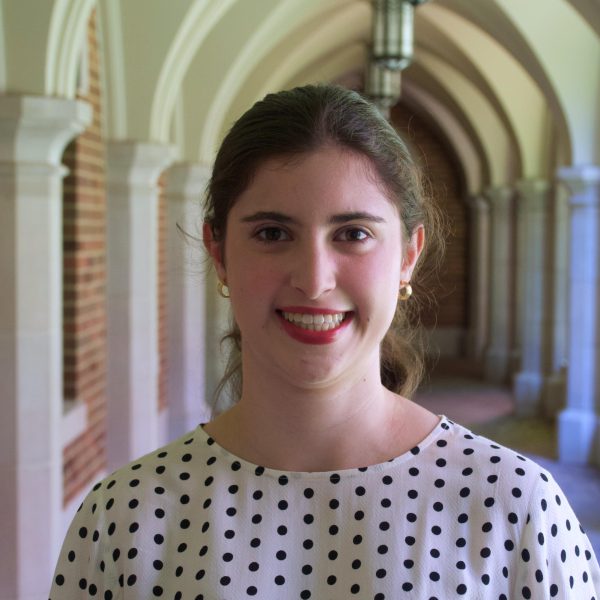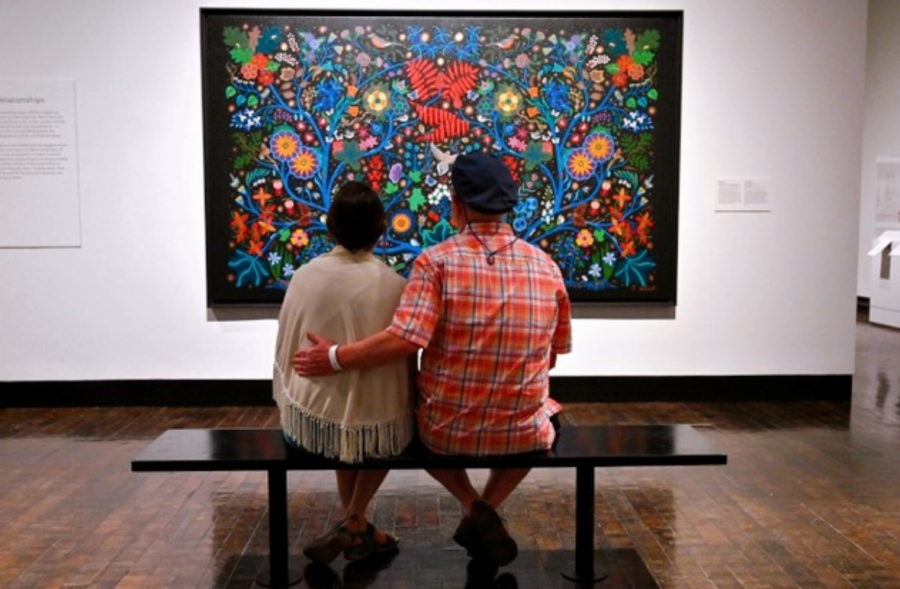The National Museum of African American Music in Nashville is the only museum of its kind, according to its website. It combines history, music and culture with visuals, sound and interactives to “educate the world, preserve the legacy and celebrate the central role African Americans play” in the American music scene. The museum is located downtown on Broadway, across from Bridgestone Arena.
The NMAAM was first proposed in 2002 by the Nashville Chamber of Commerce, with construction not beginning until 2017. The museum officially opened in 2021.
Byran Pierce, the director of curation for the NMAAM, discussed the importance of highlighting music and its role in Black history and culture.
“What is the best way to preserve your culture? I think it’s through oral traditions,” Pierce said. “The earliest form of oral traditions that we’ve had in the United States, as far as African Americans, have been through song.”
The NMAAM’s permanent gallery exhibit begins in a theater, where guests watch a 15-minute film titled “Roots.” This film discusses the roots of African American music in the culture of sub-Saharan Africa and how these musical traditions were brought to the US by the 11 million enslaved Africans transported across the Atlantic. It then explains how African American music changed as a result of the abolition of the slave trade, forced conformity to white Christianity and contact with Latin and Caribbean music styles leading up to the Civil War. Finally, the film showcases how African American music evolved during the Jim Crow era, diversifying into genres such as spirituals, disco and rock ‘n’ roll, before adopting a political tone in the R&B and rap genres many of us love today.
When the doors of the theater open, guests walk into the central section of the exhibit, titled “Rivers of Rhythm.” This section is filled with interactive tables at which guests put on headphones as they view a timeline of events related to African American history and listen to music correlated to each event. For instance, a description of the 1739 Stono Rebellion, a slave revolt in South Carolina, is coupled with Bambala Drumming from Western Congo. This feature is effective at displaying how music was used to impact history. For example, it explains how the song “Alright” by Kendrick Lamar became an anthem of the Black Lives Matter movement.
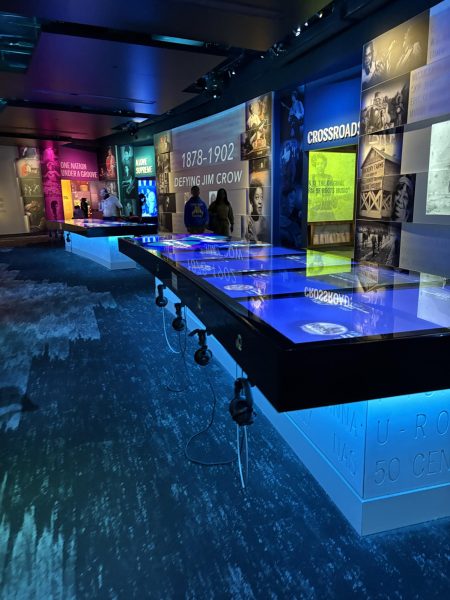
From the main room, visitors can walk into one of five mini-exhibits, each showcasing a different musical concept.
“Each one of the galleries is based upon song titles or album titles,” Pierce said. “[The exhibit] does move chronologically and also moves with the movement of people, [such as] African Americans off of plantations and to major cities. With that kind of diaspora within the United States, you have the evolution of genre.”
The “Wade in the Water” gallery covers gospel, while “Crossroads” discusses blues. Jazz is highlighted in “A Love Supreme,” R&B in “One Nation Under a Groove” and hip-hop in “The Message.” These five musical moments are not the only ways African American music can be categorized, as the numerous sub-genres, boundaries and understandings of genres are fluid.
Each mini-exhibit begins with text about the roots of the musical idea. Moving through the gallery, text on the walls explains the historical development, major moments and influential artists of the genre. For example, one panel explains how blues musician Charley Patton rose to fame while living on a sharecropper farm in Mississippi.
Each gallery presents a diverse array of visual elements. The chronologically-organized galleries showcase historical artwork, while giant photographs of influential artists such as Ella Fitzgerald, Michael Jackson and TLC, adorn the walls. The R&B and hip-hop galleries further engage visitors with videos of artists performing. Throughout all the mini-exhibits, music from the corresponding genre plays as visitors explore. There is nowhere in the NMAAM where music is not heard.
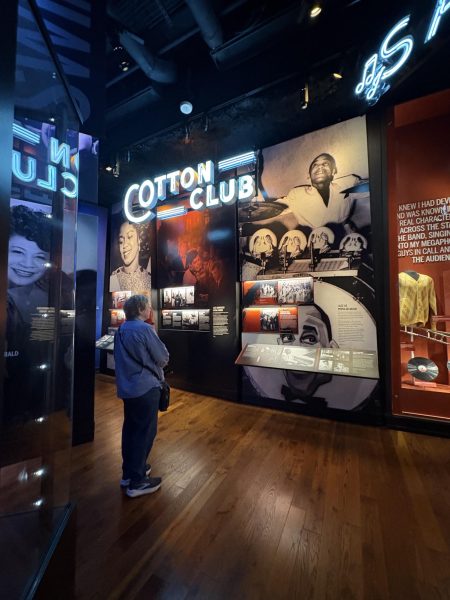
Furthermore, there are large display cases with material culture artifacts, ranging from records and albums to iconic outfits and guitars. For example, the hip-hop section includes a pair of custom thigh-high sequin boots worn by rapper Trina, a copy of TIME Magazine featuring Lauryn Hill and a signed album of the Hamilton soundtrack. Pierce discussed the process behind selecting artifacts for display.
“We’re here to preserve the history more than to try and make money,” Pierce said. “We were careful about what we took in because we wanted to make sure we were trying to tell the right story.”
The NMAAM is unique in that it contains numerous high-quality interactive features. In the gospel section, visitors can don choir robes and sing along to gospel music. They can create their own blues song with a unique storyline and improvise instrumentals to a jazz track. In my personal favorite, guests can create an R&B song or record themselves dancing to popular tracks. In the hip-hop section, visitors get a chance to craft their own beats and enter a recording studio to rap along to Nicki Minaj and Kendrick Lamar.
“What we wanted to do was blend material culture with these interactives, but making sure it was fun and was some way that can engage people, and then also knowing that it’s something that can always evolve,” Pierce said.

Each mini-exhibit features an interactive table called “Roots & Streams,” where users can click on an artist to see similar musicians categorized as mentors, peers or followers. However, this feature is limited to highly mainstream artists, missing an opportunity to introduce viewers to lesser-known artists and amplify underground voices. While the device successfully showcases female artists, it fails to adequately represent queer artists, making its curation feel incomplete.
Furthermore, when a user selects an artist, the “Roots & Streams” device automatically plays their most mainstream song, even when it lacks relevance to the social justice movements explored in the exhibit. For instance, clicking on Beyoncé triggers “Halo” instead of highlighting more political tracks like “Freedom” or “Cozy.”
“Hopefully we can talk about more people that are on the underground level, that do great work and motivate other people, but don’t have as much of a connection to the mainstream scene,” Pierce said. “I would love to do an exhibit on any type of artist or any type of genre that represents the progression of African Americans in music. As long as the story can be told well, anybody can be represented in the museum.”
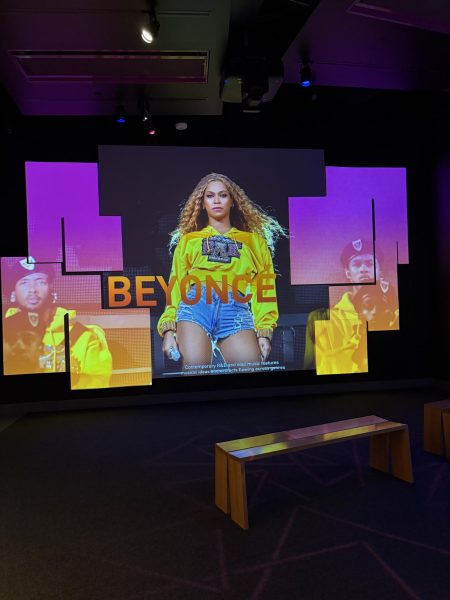
Outside of its permanent exhibit, the NMAAM contains a feature gallery for moving art exhibits and display cases showcasing artifacts in the lobby. The museum is also a center for community events, such as music performances, film screenings, gallery unveilings and even a Valentine’s Day musical dating game. The NMAAM also works on projects with other Nashville educational institutions, such as the Jefferson Street Sound Museum.
“We do a lot of collaborations with Vanderbilt,” Pierce said. “Being able to interact with different student bodies and seeing what’s on their minds, what the possibilities [are] for the future, how this can expand… I think that was a big incentive to move to Nashville and this museum.”
Overall, the NMAAM is a simultaneously educational and entertaining experience that tells a story about the creative flourishing of American culture.



